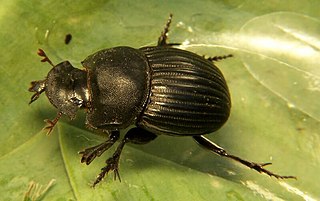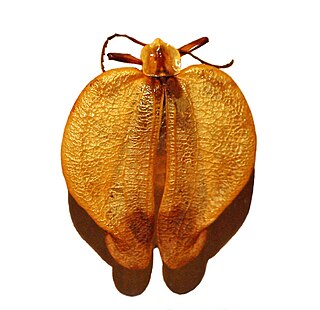
Pierre Henri Marie Schaeffer was a French composer, writer, broadcaster, engineer, musicologist, acoustician and founder of Groupe de Recherche de Musique Concrète (GRMC). His innovative work in both the sciences—particularly communications and acoustics—and the various arts of music, literature and radio presentation after the end of World War II, as well as his anti-nuclear activism and cultural criticism garnered him widespread recognition in his lifetime.

Copris is a genus of dung beetles in the tribe Coprini of the scarab family. It comprises more than 250 tunnelling species and has an almost worldwide distribution.

The Fulcidacini, sometimes known as the warty leaf beetles, are a tribe within the leaf beetle subfamily Cryptocephalinae, though historically they were often treated as a distinct subfamily, Chlamisinae. 11 genera with altogether about 400 species are currently placed here; some four-fifths of the species are found in the Neotropics, but the rest is distributed over all other continents except Antarctica.

The Arizona gray squirrel is a tree squirrel, in the genus Sciurus, endemic to the canyons and valleys surrounded by deciduous and mixed forests in eastern Arizona and northern Mexico.

Altica is a large genus of flea beetles in the subfamily Galerucinae, with about 300 species, distributed nearly worldwide. The genus is best represented in the Neotropical realm, well represented in the Nearctic and Palearctic, but occurs also in the Afrotropic, Indomalaya, and Australasia. The species are similar to each other, small metallic blue-green-bronze beetles, often distinguished from each other only by the aedeagus. The species of Altica, both as larvae and as adults, are phytophagous, feeding on plant foliage of various food plant taxa, specific for each Altica species. Onagraceae and Rosaceae are the dominant host plant families for Holarctic species. The adult Altica beetles are able to jump away when approached.

Cymindis is a genus of ground beetle native to the Palearctic, the Near East, and North Africa. It contains the following species:

Chauliognathus is a genus of soldier beetles in the family Cantharidae. Adults have almost rectangular bodies. Some are red and black, similar to the military uniforms that were common before the usage of camouflage, hence the name of soldier beetles. Others are orange and black. The elytra or first pair of wings are softer than the elytra of most beetles, that is why their other common name is leatherwings. The adults are frequently found on flowers, such as sunflowers, goldenrod, coneflowers, where they mate and feed on pollen and nectar. The larvae are more common in the ground or among debris, where they feed on eggs or larvae of other insects. The adults are most frequently found in summer and early fall. They are native to America and Australia.

Lycus is the type genus of net-winged beetles in the Lycidae family and the tribe Lycini: found in Africa and the Americas.
Rudolph Frederick Schaeffer an American arts educator and artist connected to the Arts and Crafts movement. He was the founder of the Rudolph Schaeffer School of Design, a school that was based in San Francisco and produced designers, architects, interior decorators, teachers and colorists for more than 50 years. He was one of many pioneers in the study of color field, and has been credited with establishing the city of San Francisco as an International design center.

Plateros is a genus of net-winged beetles in the family Lycidae and the tribe Platerodini. Species are recorded from the Americas, Africa and Asia, including Sri Lanka, Indochina, Korea and Japan.

Phyllobaenus is a genus of checkered beetles in the family Cleridae. There are at least 60 described species in Phyllobaenus.
Eusphyrus is a genus of fungus weevils in the family Anthribidae. There are at least 30 described species in Eusphyrus.

Dryops is a genus of long-toed water beetles in the family Dryopidae. There are at least 20 described species in the genus Dryops.

Collops is a genus of soft-winged flower beetles in the family Melyridae. There are more than 30 described species in Collops.
Neltumius is a genus of pea and bean weevils in the beetle family Chrysomelidae. There are at least three described species in Neltumius.
Colaspis arizonensis is a species of leaf beetle from North America. It is found in southeast Arizona and northwest Mexico. It was first described by the American entomologist Charles Frederic August Schaeffer in 1933.

Polemius is a genus of soldier beetles in the family Cantharidae. There are about 16 described species in Polemius.

Charles Frederic August Schaeffer was an American entomologist who specialized in beetles, particularly chrysomelids and weevils. He described 109 species in 91 genera and some species like Taphrocerus schaefferiNicolay & Weiss were described from his collections and named after him.













